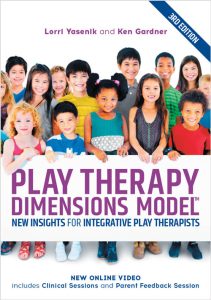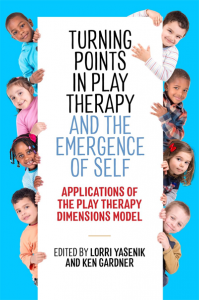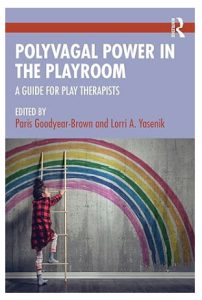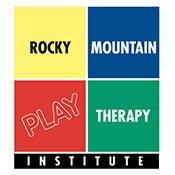Find our books on Amazon in your country or directly from our publisher.
 Play Therapy Dimensions Model: New Insights for Integrative Play Therapists
Play Therapy Dimensions Model: New Insights for Integrative Play Therapists
Written by Lorri Yasenik and Ken Gardner
What is the Play Therapy “Dimensions” Model”?
- It is a framework for decision-making in play therapy.
- It considers “How directive are you?” and “How consciously” are you bringing things forward in a play therapy session?
- The two dimensions cross to form 4 quadrants:
- I Active Utilization
- II Open Discussion and Exploration
- III Non-Intrusive Responding
- IV Co-facilitation
Different theories/models fit within each of the quadrants. For instance, in QI: Open Discussion and Exploration, you will find a therapist using more directive prompts or therapy interventions such a Cognitive Behavioral Play Therapists. QIII: Non-intrusive Responding is likely the most commonly known by play therapists, as all of the non-directive practices fall within this quadrant such as Child Centered Play Therapy, Humanistic Play Therapy, and UK Non-directive play therapy. QI: Active Utilization is where a play therapist may be making interpretive comments that come from the play themes or characters, or even things that the child has directly shared. You will find many different theories working here from time to time such as Adlerian Play Therapists, Eriksonian Play Therapists, Gestalt Play Therapists etc. In QIV: Co-facilitation, you will find many play therapy models such as Gestalt, Adlerian, UK Non-directive, Theraplay play Therapists and other theoretical orientations. In this quadrant you may be using a character in a way a child has not directed or entering new ideas into the play.


Turning Points in Play Therapy and the Emergence of Self: Applications of the Play Therapy Dimensions Model
Edited by Lorri Yasenik and Ken Gardner
Effective clinical practice requires a thorough understanding of how turning points surface in the play therapy process. These moments can indicate a change in a child's thought or behaviour. The play therapist is the facilitator of these moments and this book will provide guidance on how they can promote these moments.
This edited collection demonstrates successful implementation of the author's proven Play Therapy Dimensions Model. Each chapter uses this framework, as well as other theories, to discuss the markers that can reflect shifts and growth in a child's development. Full of applied guidance, this book will prove to be invaluable for practitioners, instructors and students.

Polyvagal Power in the Playroom: A Guide for Play Therapists
Edited by Lorri Yasenik and Paris Goodyear-Brown
Polyvagal Power in the Playroom shows therapists how to treat children using play therapy to address the hierarchy of autonomic states. What do children need and how do play therapists purposefully use the principles of play to increase the feeling states of safety and regulation? Step inside the playroom and discover how trained play therapists are addressing treatment using polyvagal theory when working with children and teens.
"Paris Goodyear-Brown and Lorri Yasenik bring a new resource to Play Therapists! Step inside the playroom and discover how trained play therapists are addressing treatment using Polyvagal Theory when working with children and teens."
